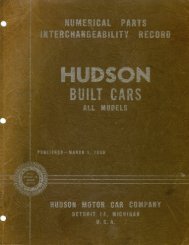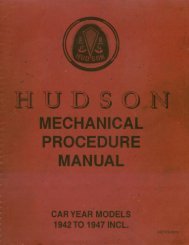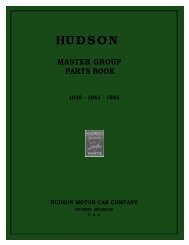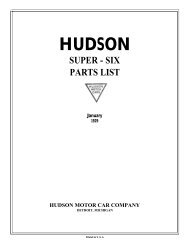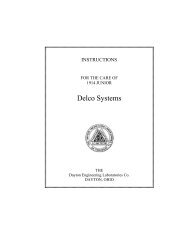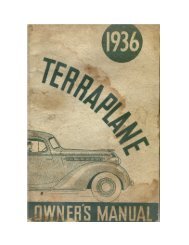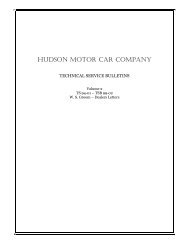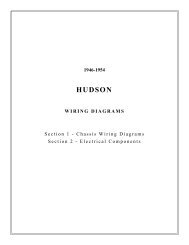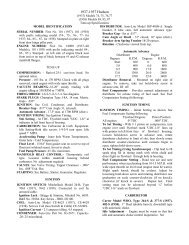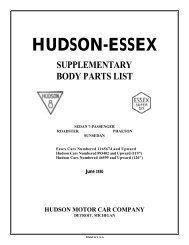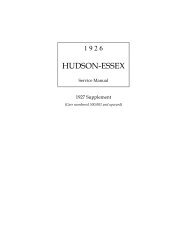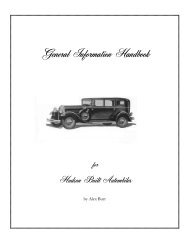1948-1952 Shop Service Manual - - Hudson-Essex-Terraplane Club
1948-1952 Shop Service Manual - - Hudson-Essex-Terraplane Club
1948-1952 Shop Service Manual - - Hudson-Essex-Terraplane Club
Create successful ePaper yourself
Turn your PDF publications into a flip-book with our unique Google optimized e-Paper software.
OVERDRIVE 9 - 3<br />
NOTE: Unless otherwise designated all instructions and<br />
operations are for overdrive transmissions used with either<br />
the single lever type or double lever type manual<br />
control transmissions.<br />
TRANSMISSION OVERDRIVE<br />
used, making available the acceleration so desirable at<br />
lower speeds. As the car speed increases above the cut-in<br />
point the overdrive unit will shift into overdrive ratio, but<br />
only when the driver desires no further acceleration;<br />
when consciously, or unconsciously, he lifts his foot<br />
from the accelerator, whereupon the shift is completed.<br />
Thereafter, the overdrive remains in effect until the car<br />
speed falls below the "cut-out" points, 16 to 19 mph,<br />
when the overdrive is released.<br />
However, at high speeds, the driver while operating in<br />
overdrive may require additional acceleration beyond<br />
that available by opening the throttle wide. His natural<br />
impulse is to press the accelerator further, and his act<br />
releases the overdrive, making available the full acceleration<br />
of direct drive. The direct drive is retained as long<br />
as the full acceleration is required; when the driver no<br />
longer requires it he lifts his foot from the accelerator,<br />
whereupon the overdrive is resumed. If the driver so<br />
desires, he may retain the direct drive indefinitely by<br />
maintaining a small amount of throttle opening.<br />
CITY TRAFFIC DRIVING:<br />
FIGURE 3<br />
OPERATION<br />
Overdrive provides a driving ratio of engine speed to<br />
rear wheel speed that is numerically lower than direct<br />
drive. In overdrive the engine revolves 30% slower than in<br />
direct gear at the same car speed, resulting in less wear on<br />
engine parts as well as greater fuel and oil economy and<br />
smoother operation at high speeds.<br />
HIGHWAY DRIVING:<br />
When the car is operated below a predetermined "cutin"<br />
speed, varying from 18 to 21 mph, the direct drive is<br />
Much city driving is under conditions which permit<br />
speeds of 20-32 mph, with frequent stops. Many drivers<br />
are accustomed to start in second gear under such conditions.<br />
With overdrive-equipped cars, the driver may start<br />
in second gear, accelerate up to the "cut-in" speed, an, by<br />
merely lifting the foot from the accelerator pedal, engage<br />
the overdrive-second gear combination, which is approximately<br />
the same ratio as the usual third speed. At the<br />
first traffic stop, it is merely n e c e s s a r y to release the<br />
clutch; the gear shift lever is not touched. Furthermore,<br />
if a special burst of acceleration is needed in a tight traffic<br />
spot, the full power of second gear may be had by pressing<br />
the accelerator to the floor, resuming the overdrivesecond<br />
by the usual method of closing the throttle.



